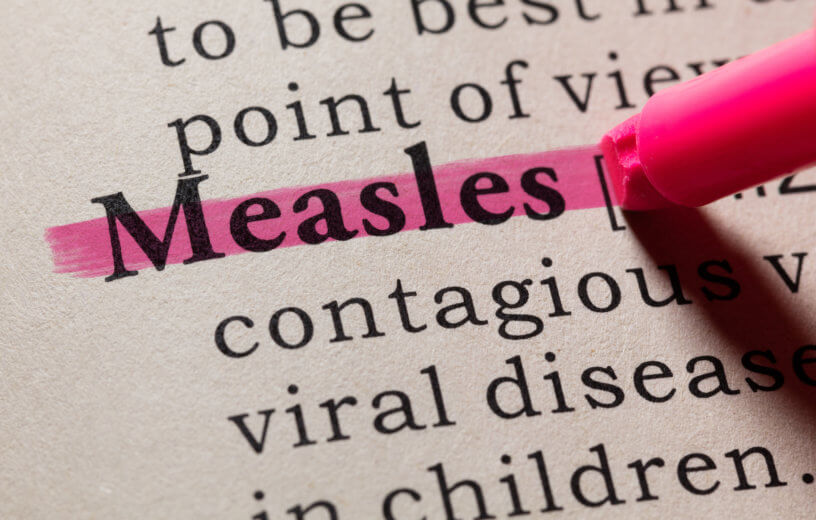At one time, measles was a common childhood illness. Then, the measles vaccine and its aggressive application was introduced in 1963. It was so effective that the Centers for Disease Control and Prevention (CDC) declared the disease eradicated across the United States in 2000. In just the last few months, however, alarming outbreaks of measles have occurred in pockets around the country.
There are confirmed cases in parts of California, Delaware, Florida, Georgia, Pennsylvania, Maryland, Missouri, New Jersey, New York, Ohio, and Washington. Both the CDC and the World Health Organization (WHO) describe the trend as a rapidly growing global threat. So, the first question is — why is this happening now?
Why the surge?
The spread of measles virtually stopped during the COVID-19 pandemic, but it caused many children to miss their doctor’s visits, so fewer children were vaccinated compared to before the pandemic. The CDC estimates that more than 61 million doses of measles vaccines were either postponed or missed from 2020 to 2022 due to the pandemic.
The pandemic also fueled the anti-vaccine movement — despite infectious disease experts and health officials emphasizing to the public that vaccines are safe and prevent disease.
Last year, the CDC also found school vaccination exemptions were the highest on record among kindergarteners, with measles vaccination rates lower than pre-pandemic levels at 93.1 percent. Experts say this is below the 95 percent threshold needed for herd immunity for measles, where enough of a population is vaccinated so that even if some people get measles, outbreaks do not occur.

What To Know About Measles
Measles is a viral illness, so contagious that of 10 nonimmunized people exposed to it, nine will develop the illness. The virus lives in the mucous of the nose and throat, and is spread by coughing and sneezing, like COVID-19.
Prior to the vaccine, there were three to four million cases annually in the United States, with 400 to 500 deaths. Aggressive vaccination prevents more than 99 percent of potential cases. The symptoms are fever, cough, runny nose, watery eyes, and a characteristic red rash. Most measles cases are mild, with full recovery likely. Common, non-threatening complications include ear infections in children and diarrhea in adults.
Complications can be severe, even deadly. One out of five nonimmunized people who develop the illness will require hospitalization. The people at greatest risk for severe complications are children younger than five years-old or not fully immunized, people older than age 20, pregnant women, and those with compromised immune systems (such as patients with cancer or autoimmune disorders).
Severe complications include:
- 1 in 20 children will develop pneumonia, which is the most common cause of death in children with measles.
- 1 in 1,000 children will develop encephalitis (swelling of the brain), with the potential for seizures and permanent intellectual disability.
- 1 to 3 of 1,000 children will die from respiratory or neurologic complications.
- Premature delivery and low birth weight can occur in pregnant women who contract measles.
- Subacute sclerosing panencephalitis (SSPE) is a very rare, but fatal disease of the central nervous system which can occur in adults. It results from a measles infection acquired earlier in life.
The last major outbreak of measles in the U.S. occurred in 2019, when there were 1,274 individual cases confirmed in 31 states, according to the CDC. This was the highest number of reported cases in the U.S. since 1992, with most cases among those who were unvaccinated.
How Do You Prevent Measles?
There is only one way to prevent the spread of measles: Immunization, in both children and nonimmune adults.
Discuss the dosing schedule with your physician. Children should receive two doses of the measles vaccine. The first should be at age 15 to 18 months; the second should be between the ages of four and six.
Keeping your child away from others with measles is not particularly effective, because people can spread the disease for several days before symptoms appear. If you are a parent and suspect that your child has measles, do not take your child to an emergency department or to the doctor’s office unless special arrangements have been made first. The risk for adding to the spread of the disease is much too great, and there is risk of exposure to others who may be contagious.

…and NOT A SINGLE WORD about 10,000 unvetted individuals coming into America from far less medically advanced areas daily through less than legal means?
Hmmm!